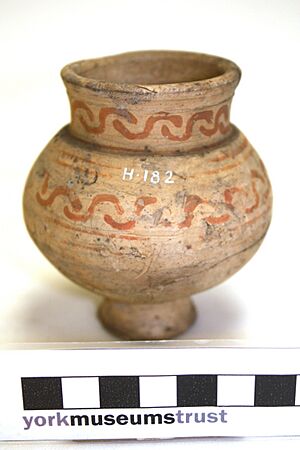Crambeck Ware facts for kids
Crambeck Ware is a special type of Romano-British pottery. It was made in North Yorkshire, England, mostly during the 4th century AD. This pottery is named after the village of Crambeck, where many ancient kilns were found.

Contents
Where Was Crambeck Ware Made?
The pottery industry got its name from the village of Crambeck. This village is about 8 kilometers (5 miles) from Malton. It's also about 24 kilometers (15 miles) from York. The old Roman kilns (ovens for firing pottery) at this site are now a protected historical place.
Finding the Kilns
People first found pottery from six kilns in the mid-1800s. This happened when Crambeck School was being built. A local newspaper, the Malton Messenger, wrote about these discoveries in 1858.
Philip Corder's Digs
A man named Philip Corder started digging here in 1926. He worked with students from Bootham School. They found four kilns between 1926 and 1927. Later digs showed many small areas with kilns still there. Besides the kilns and waste piles, the site also had places for clay, fuel, and drying. There were also workshops and possibly homes for the workers.
A Big Pottery Business
The Crambeck Ware industry was one of two main pottery businesses in Yorkshire during Roman times. The other was Huntcliff ware. Not much Crambeck Ware is found south of the Humber River. But it did travel north, towards the Roman frontier. The kilns found were all round with a limestone flue (a channel for smoke).
Types of Crambeck Pottery
There are three main types, or "fabrics," of Crambeck Ware. These are Grey Ware, Red Ware, and 'Parchment' Ware. The most common type is Grey Ware, which was made starting around AD 280. All Crambeck pottery uses a fine clay. This clay has tiny bits of shiny mica and different amounts of quartz. The mortaria (bowls for grinding food) have rough bits of slag mixed in.
Grey Ware
This pottery is hard and has a fine texture. It's usually very pale grey inside, sometimes almost white. The outside surfaces are a medium grey. It has many tiny bits of quartz sand. The surfaces are often smooth and shiny from being polished on a potter's wheel.
Parchment Ware
'Parchment' ware is a group of hard, brittle pottery. It can be white, buff (a light yellowish-brown), yellow, or orange. It breaks in thin layers. This pottery has lots of fine sand mixed in to make it stronger. It often has orange or brown painted designs. The mortaria of this type have iron slag grits. Crambeck Parchment Ware is often painted with red patterns. These can be bands around the pot, geometric shapes, dots, or diagonal lines. Sometimes, they even show human faces on special "face pots."

Red Ware
Red ware is a softer type of pottery. It has an orange color inside. The outside surfaces are polished and orange-red. It has different amounts of sand and soft reddish-brown bits mixed in.
Where to See Crambeck Ware
You can find collections of Crambeck Ware at these places:
See also
- Philip Corder
- Dales ware
- Huntcliff ware
- Ancient Roman Pottery
- List of Romano-British pottery

